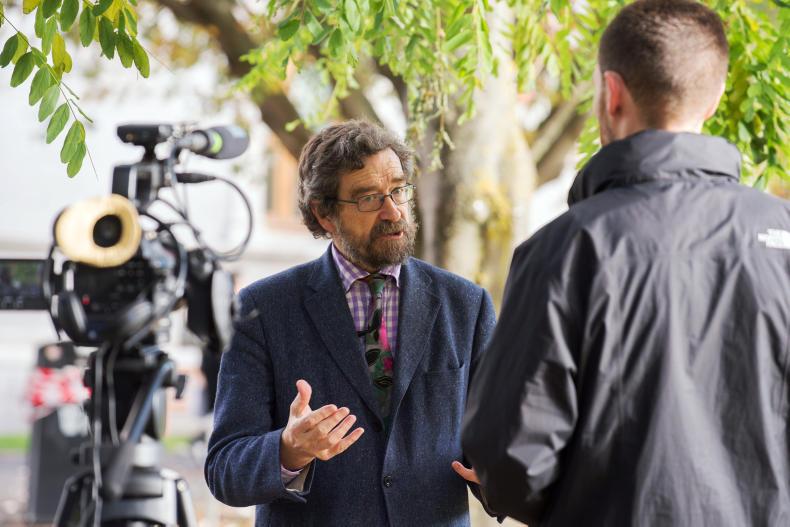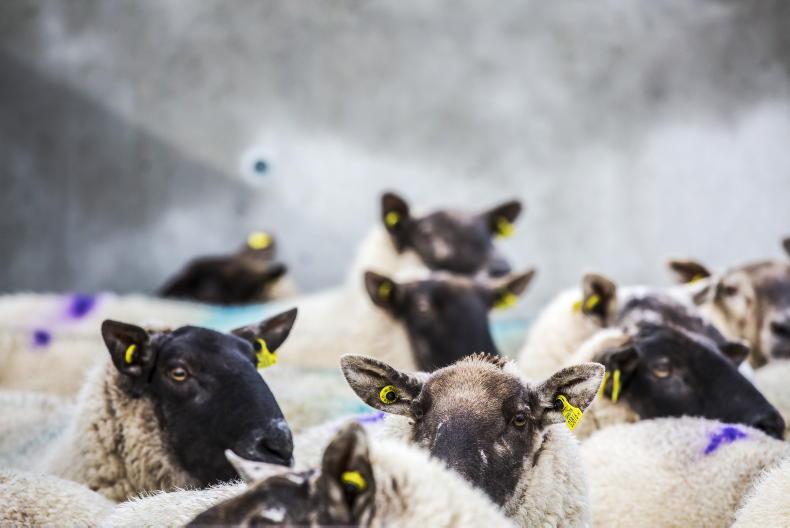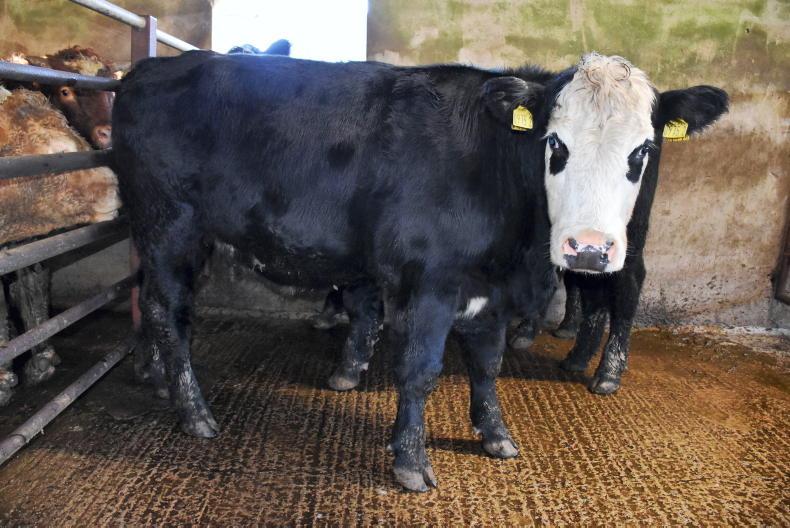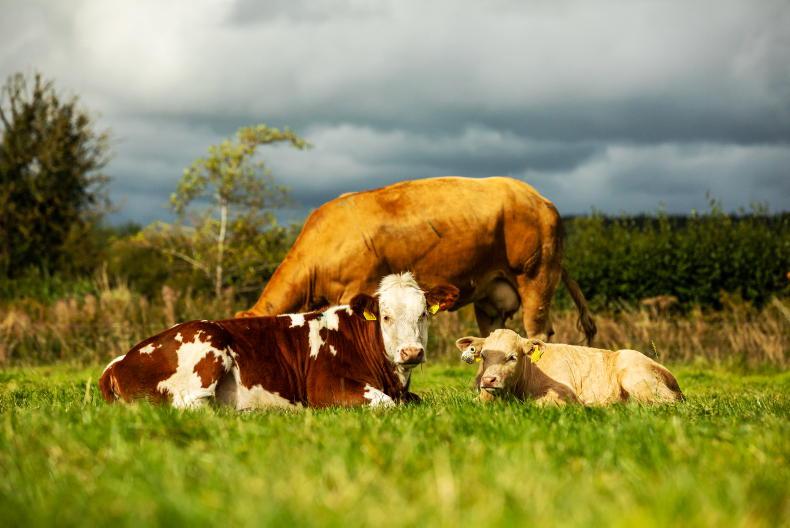A large-scale, structured cull of the national beef herd has been called for by the Climate Change Advisory Council.
With agriculture accounting for 32.1% of greenhouse gas emissions in 2017 – the highest of any sector in Ireland – the council’s annual review states that drastic measures are needed to reduce emissions.
The review outlines three scenarios for reducing suckler numbers:
Scenario A: suckler numbers continue to decline at the current rate of 1.4% per annum.
This would lead to a 15% reduction (152,000 head) by 2030 and total emissions from agriculture would fall to 1.7% below 2017 levels.
Scenario B: suckler numbers to be cut by 30% (304,000 head) by 2030.
Emissions from agriculture would fall 5.4% below 2017 levels.
Scenario C: suckler numbers to be cut by 53% (536,000 head) by 2030.
This would bring the national suckler herd number down to the 1984 pre-milk quota level of 479,000 head and bring emissions to 10.9% below 2017 levels.
Chair of the Climate Advisory Council Professor John Fitzgerald told the Irish Farmers Journal that he favours either scenario B or C because the reduction outlined in scenario A “would not be adequate.”
Dairy impact
The dairy sector is also under the spotlight and in each scenario dairy herd numbers are to be maintained at 2018 levels.
Fitzgerald said that there is limited room for expanding the dairy herd beyond current levels. He said the growth of dairy numbers would only be possible based on the uptake of Teagasc’s MACC measures and the exodus of the suckler herd.
“A bigger reduction in beef would leave some room for a bit more on the milk side, but that is something that has to be worked out,” he said.
The Council has suggested that the structured cull could be funded through the use of payments in the next Common Agriculture Policy (CAP).
Beef prices
The report points out the majority of beef farms are not currently viable operations. It states that the drop in total cattle numbers could help to increase overall cattle prices.
Fitzgerald also expressed the belief that with Brexit expected to have a devastating impact on the Irish beef trade, that Government financial support for the beef sector should be linked to major herd reduction.
Farmland
The Council wants farmers who reduce suckler numbers to plant trees on their land or explore biomass options, including growing grass for anaerobic digesters.
Essentially, the Council doesn’t want beef farmers to switch to dairy farming leading to another wave of expansion and rise in cattle numbers.
“A lot of land that has been in relatively un-intensive beef or cattle is not actually very good quality land, it may be that it would be more profitable to use it in other ways,” Fitzgerald said.
The report says that the drainage of peatlands also needs to be “urgently addressed”. It also comments that grassland used for extensive agriculture activity could be rewetted but that this would need to be considered on a case-by-case basis.
The report has been welcomed by Minister for Communications, Climate Action and Environment, Richard Bruton who said: “While the focus of the recently published plan has been on the reduction in greenhouse gas emissions, the Advisory Council’s report is a timely reminder that we must also ensure that appropriate consideration is given to embedding robust adaptation measures across the system. This feedback will be taken into account as we develop our 2020 Plan."
Read more
Mart prices: thriving cattle softening the brunt of market volatility
Brazil’s climate commitment cannot be taken at face value – ICSA
A large-scale, structured cull of the national beef herd has been called for by the Climate Change Advisory Council.
With agriculture accounting for 32.1% of greenhouse gas emissions in 2017 – the highest of any sector in Ireland – the council’s annual review states that drastic measures are needed to reduce emissions.
The review outlines three scenarios for reducing suckler numbers:
Scenario A: suckler numbers continue to decline at the current rate of 1.4% per annum.
This would lead to a 15% reduction (152,000 head) by 2030 and total emissions from agriculture would fall to 1.7% below 2017 levels.
Scenario B: suckler numbers to be cut by 30% (304,000 head) by 2030.
Emissions from agriculture would fall 5.4% below 2017 levels.
Scenario C: suckler numbers to be cut by 53% (536,000 head) by 2030.
This would bring the national suckler herd number down to the 1984 pre-milk quota level of 479,000 head and bring emissions to 10.9% below 2017 levels.
Chair of the Climate Advisory Council Professor John Fitzgerald told the Irish Farmers Journal that he favours either scenario B or C because the reduction outlined in scenario A “would not be adequate.”
Dairy impact
The dairy sector is also under the spotlight and in each scenario dairy herd numbers are to be maintained at 2018 levels.
Fitzgerald said that there is limited room for expanding the dairy herd beyond current levels. He said the growth of dairy numbers would only be possible based on the uptake of Teagasc’s MACC measures and the exodus of the suckler herd.
“A bigger reduction in beef would leave some room for a bit more on the milk side, but that is something that has to be worked out,” he said.
The Council has suggested that the structured cull could be funded through the use of payments in the next Common Agriculture Policy (CAP).
Beef prices
The report points out the majority of beef farms are not currently viable operations. It states that the drop in total cattle numbers could help to increase overall cattle prices.
Fitzgerald also expressed the belief that with Brexit expected to have a devastating impact on the Irish beef trade, that Government financial support for the beef sector should be linked to major herd reduction.
Farmland
The Council wants farmers who reduce suckler numbers to plant trees on their land or explore biomass options, including growing grass for anaerobic digesters.
Essentially, the Council doesn’t want beef farmers to switch to dairy farming leading to another wave of expansion and rise in cattle numbers.
“A lot of land that has been in relatively un-intensive beef or cattle is not actually very good quality land, it may be that it would be more profitable to use it in other ways,” Fitzgerald said.
The report says that the drainage of peatlands also needs to be “urgently addressed”. It also comments that grassland used for extensive agriculture activity could be rewetted but that this would need to be considered on a case-by-case basis.
The report has been welcomed by Minister for Communications, Climate Action and Environment, Richard Bruton who said: “While the focus of the recently published plan has been on the reduction in greenhouse gas emissions, the Advisory Council’s report is a timely reminder that we must also ensure that appropriate consideration is given to embedding robust adaptation measures across the system. This feedback will be taken into account as we develop our 2020 Plan."
Read more
Mart prices: thriving cattle softening the brunt of market volatility
Brazil’s climate commitment cannot be taken at face value – ICSA









SHARING OPTIONS